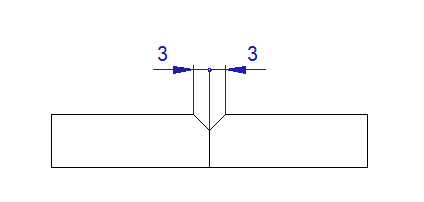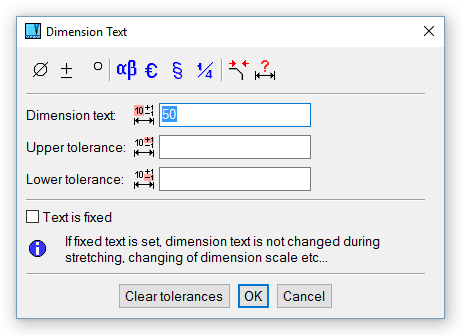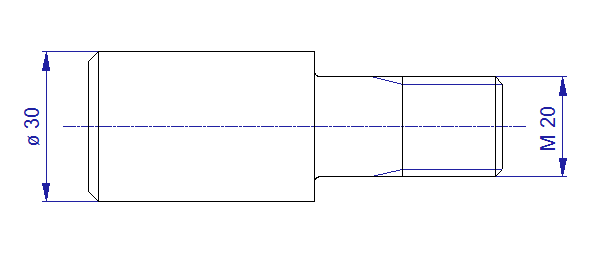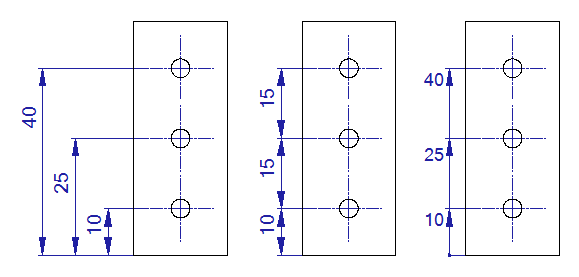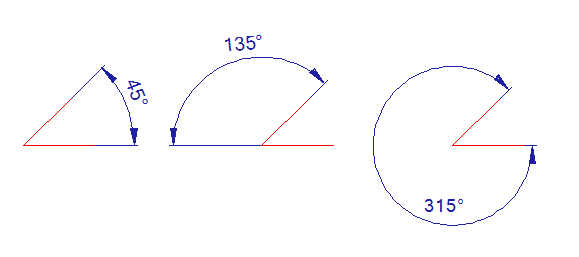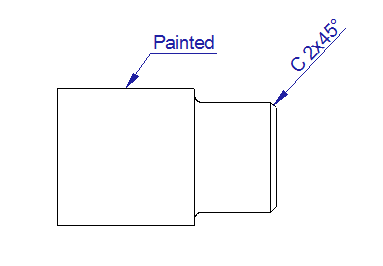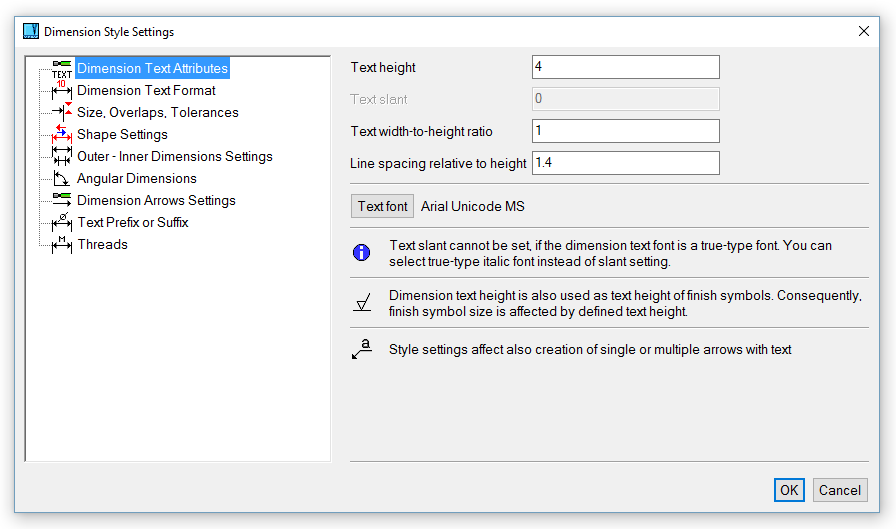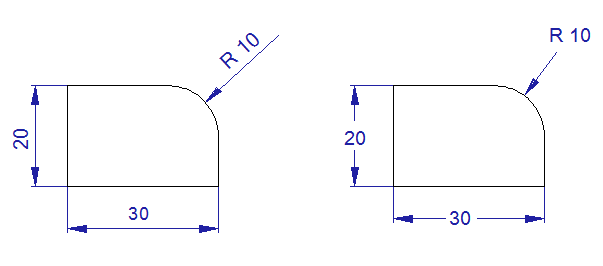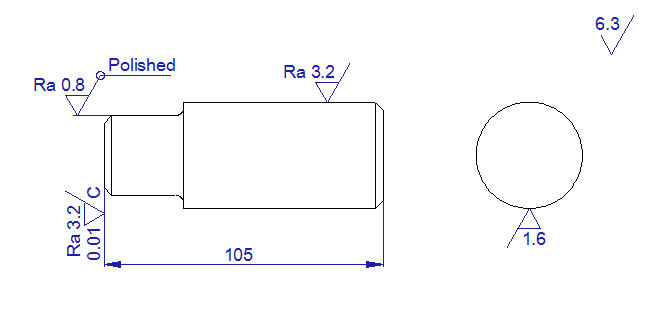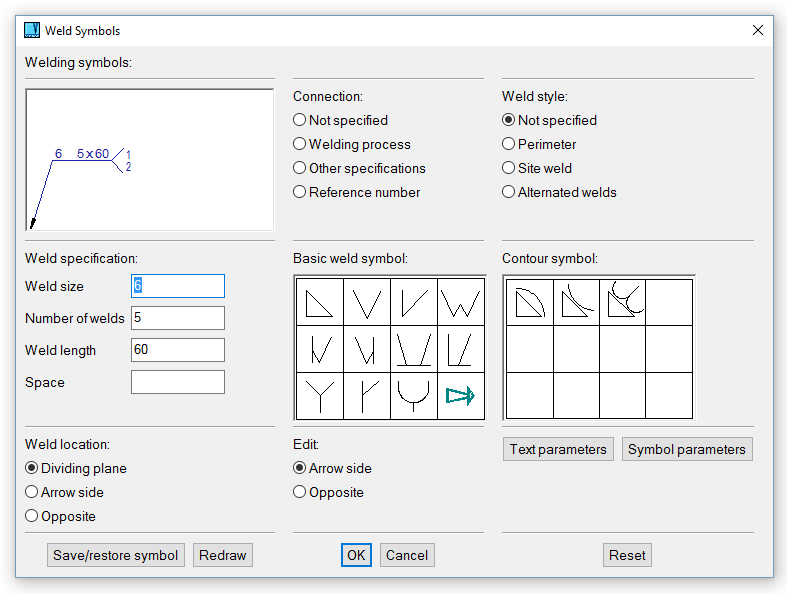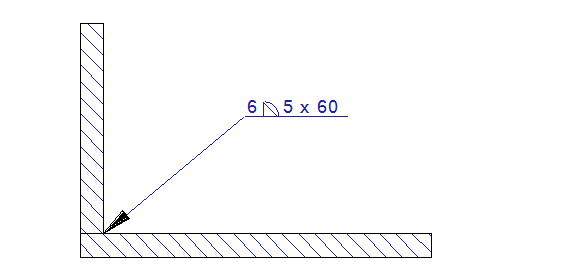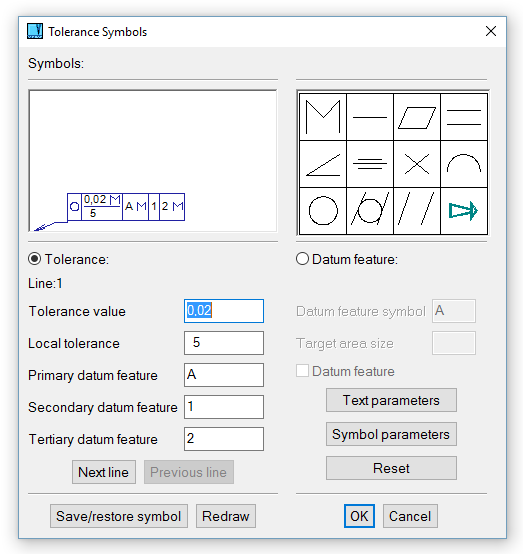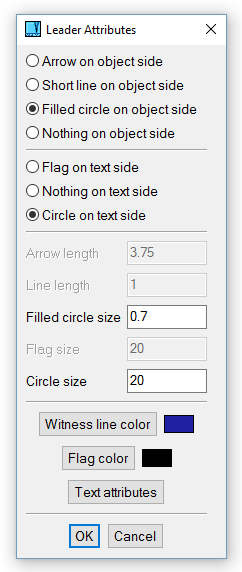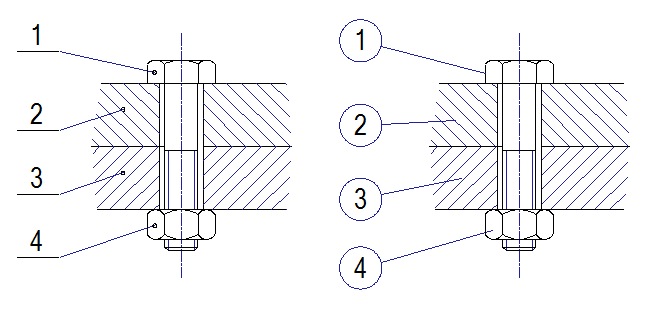Dimensioning
Dimensioning enables you to describe geometry by displaying measurements. All dimensioning functions can be found on the Dimensioning toolbar or in the Objects / Draw menu. To create dimensions, select the objects to measure and drag the mouse to locate the dimension text (see Dragging Objects ). Dimensioning tools have several options for additional formatting and settings.
Once created, the dimensions can be easily edited (see Editing Dimensions ). Format and style of dimensions and dimension text can be modified using Dimension Attributes. Changing dimension text height affects the length of leader lines arrows.
Single Dimensions - Horizontal, Vertical and Diagonal
 | Horizontal Dimension - HDI |
 | Vertical Dimension - VDI |
 | Diagonal Dimension - SDI |
Single dimensions are defined by selecting start and end points, then locating the dimension text.
 | Change Dimension Shape - Before the text location is defined, you can change the current dimension format. You can also use Dimension Format to set the format of future dimensions. |
Dimension Format provides the following options:
- Center dimension text - for the current dimension, all texts will be automatically centered. If turned on, this option turns centering off.
- Toggle points and arrow - switches between points and arrows on the leader lines. This option is useful when space is limited.
- Cancel predefined level - cancels all other previously selected options, the dimension is created at level exactly defined by cursor location.
These options of Dimension Format allow you to define the level (text location and dimensioning line location) of created dimension or all future dimensions:
- Created dimension at the same level as selected (according to a selected dimension)
- All dimensions at the same level as selected
- All dimensions at the same level as created (next dimensions are according to the currently created dimension)
- Created dimension parallel to selected
- All dimensions are parallel to selected
- All dimensions are parallel to created
The last option from menu allows you to redefine the dimension style.
Dimension arrows changed
 | Change Dimensioning Scale |
Dimension scale value multiplies measured values of linear, diameter or radius dimensions. It must be used, if a part of 2D drawing is created in different drawing scale than entire drawing (for instance, in case of enlarged details).
 | Change Text or Tolerance - modify the dimension text or tolerances. |
Dimension text is created automatically, and you can use Dimension Attributes to define its parameters. For currently created dimension, you can change text in the text input window.
You can select this option by clicking the corresponding icon in toolbar, from pop-up menu (available by default after Ctrl + Right-click), or, very conveniently by pressing TAB during dimension text location. The last possibility allows you to easily select the input text field, if you press TAB repeatedly – input is changed from dimension text to upper, then lower tolerance.
Dimension text window offers you to enter special characters, by clicking the corresponding icons.
Change dimension text window
Predefined Horizontal, Vertical and Diagonal Dimensions
Predefined dimensions contain standard text characters such as diameter symbols. These are useful when dimensioning objects like circles or threads.
 | Horizontal Diameter Dimension - HDM |
 | Vertical Diameter Dimension - VDM |
 | Diagonal Diameter Dimension - SDM |
 | Horizontal Thread Dimension - HTH |
 | Vertical Thread Dimension - VTH |
 | Diagonal Thread Dimension - STH |
Example of predefined dimensions
Serial, Parallel and Datum Dimensions
These functions create multiple dimensions. The first dimension in this group is defined as for single dimensions (by 2 points), and subsequent dimensions in the group require only one point.
Parallel dimensions are a group of dimensions that all start at the same point. The offset between parallel dimensions is defined in Dimension Attributes. Datum dimensions consist of a line of points, at each of which the dimension defines the total distance from the start point. Serial dimensions are a chain of aligned dimensions that define the distance from point to point.
 | Horizontal Parallel Dimensions - HPD |
 | Horizontal Serial Dimensions - HSD |
 | Horizontal Datum Dimensions - HDD |
 | Vertical Parallel Dimensions - VPD |
 | Vertical Serial Dimensions - VSD |
 | Vertical Datum Dimensions - VDD |
 | Diagonal Parallel Dimensions - SPD |
 | Diagonal Serial Dimensions - SSD |
 | Diagonal Datum Dimensions - SDD |
Example of baseline, serial and datum dimensions
Angular Dimensions
 | Angular Dimension - ADI |
Angular dimensions define the angle between two lines. You have the same additional options for dimension shape changes as for the linear dimensions. See Change Dimension Shape.
For angular dimension, define first and second line. When the second line is defined, you can optionally select following:
 |
Greater Than 180 - dimensions the angle greater than 180 degrees. |
 |
Turn off dimensioning of angle greater than 180 degrees, cancels the previous mode. |
 |
Complementary Angle On - dimensions the angle complementary to 180 degrees. |
 |
Complementary Angle Off - turns off the complementary angle dimensioning, cancels the previous mode. |
Example of default angular dimensioning, complementary angle dimensioning and dimensioning of angle greater than 180 degrees
Diameter and Radius Dimensions, Thread Dimensions
 | Radius Dimension - RDI |
 | Diameter Dimension - DDI |
These dimensions are defined by selecting an arc or circle and locating the dimension text. Additional options for radius dimensions are:
- Extend to radius center - creates a mark at the arc center.
- Not to extend to radius center – cancels the previous mode.
 | Thread dimensions - THR |
 | Horizontal Thread Dimension - HTH |
 | Vertical Thread Dimension - VTH |
 | Diagonal Thread Dimension - STH |
Thread dimensions behave like diameter or linear dimensions, except the predefined thread symbol is used. If the thread is created in 3D and then exported into 2D, either in sections or in a view, the dimension text is created automatically according to corresponding 3D object. Dimension recognizes thread type (like Metric thread, Pipe thread), and thread size or pitch (like M10, M10x1 …). It is necessary to use these four dimensioning commands to obtain the corresponding thread text, according to creation in 3D. Also, threads should be exported to 2D from basic views (like front view, back view, top view…).
 | Single Text Arrow - STXA |
Creates a text connected to a single arrow.
 | Multiple Text Arrow - MTXA |
Creates multiple lines of horizontal text connected to an arrow.
Example of text connected to an arrow
Dimension Attributes
 | Dimension Attributes - DMA |
Available on the Tools menu, Dimension Attributes enables you to change dimension styles and other properties. The following properties can be modified:
- Text attributes - height, slant, width and font. Text height controls the size of leader arrows.
- Dimension text format – number of decimal digits, usage comma instead of period, inch values format
- Size, overlaps, tolerances - distance between parallel dimensions, distance between text and leader lines, witness line creation, tolerance position
- Angular dimensioning
- Arrow style
- Text prefix or suffix – defines usage of radius, diameter or thread marks
Changing dimension attributes allows you to set dimensioning according to various drawing standards, like DIN or ANSI. Dimension attributes are used also for finish symbols or single or multiple text arrows.
 | Edit Style of Selected Dimensions - EDS |
This command changes the style of selected dimension or dimensions (also from entire drawing) to a style of a selected dimension, or according to current dimension style settings.
Dimension style settings
Example of dimension styles
Finish Symbols
 | Finish Symbols - FSY |
Finish symbols are created by entering a roughness value, or by selecting a symbol for not-machined surfaces. Symbols can be attached to a line, arc or dimension witness line, or they can float. When attaching to a 2D object, you can drag the symbol around the object before selecting its final position.
Finish symbols example
Weld and Tolerance Symbols
 | Weld Symbols - WSY |
The weld symbol includes a basic symbol, supplementary symbol, dimension of weld size, and weld process symbol. When defining a symbol, you can change text and other attributes, and see a preview before creating it. You can also save up to nine symbols for future use. To create a weld symbol, first select the weld location and then select the symbol location.
Welding symbols definition
Example of welding symbol; this symbol was created within one function.
 | Weld Symbol Settings - SWS |
Available on the Tools menu, allows you to choose whether the weld symbols will be created according to ISO or ANSI standards.
 | Tolerance Symbols - TSY |
Similar to welding symbols. Datum feature symbols can also be created.
Tolerance symbols definition
Creating Leaders
 | Leaders - POS |
Leaders are typically used in 2D assembly drawings. Leader attributes are defined first, then the location on a 2D object, and then the location of the leader text. Text positions must be defined for the first and second leaders. The DX and DY values of the two leader texts are used to locate texts for the next leader. After the first leader, you need only to define the 2D object for the next leader and confirm the text position, and the value of each leader is automatically increased. As with dimensions, the leader value can be modified in the text window of the temporary toolbar. While defining leader positions, the following options are available:
 |
Leader Attributes - modify leader attributes |
 |
Leader Distance - define distance between adjacent leaders. This setting is useful only when dragging requires the left mouse button to be pressed. |
 |
Leader Text Attributes - modify leader text and text properties |
Leader definition
Example of leaders
Editing Dimensions
 | Edit Dimension Text - EDI |
Edits the text of a selected dimension. The same text editing options are available as when you created the dimension.
 | Move Dimension Text - MDT |
Uses drag and drop to move the text of a selected dimension. Be careful when using this function, because if you create more dimensions after moving the text, you could have overlapping objects.
 | Edit Dimension - EDM |
Change any attribute of a dimension. You can change everything about a dimension except for the original dimension definition points or the 2D dimensioned object. Dimension shape is defined the same way as if you create a new dimension. Similarly, you can change style, text or dimension shape.
